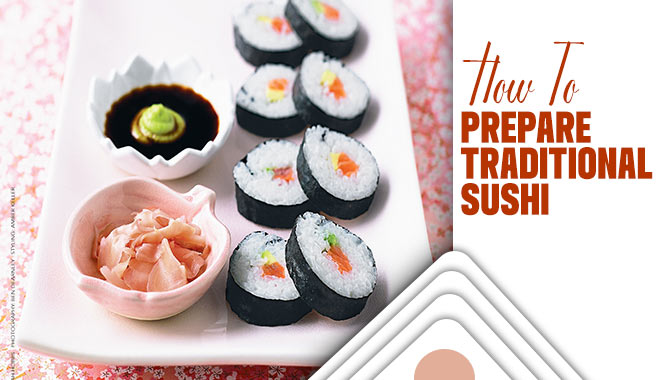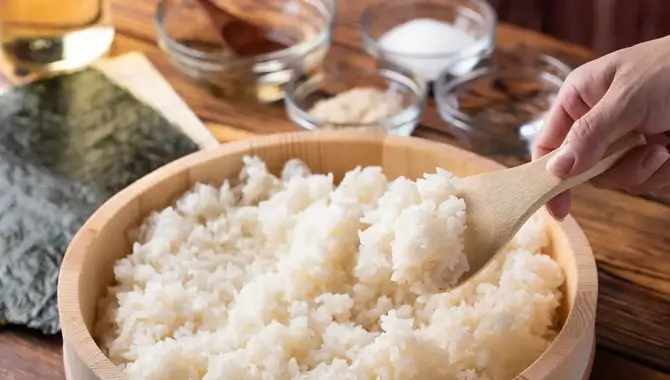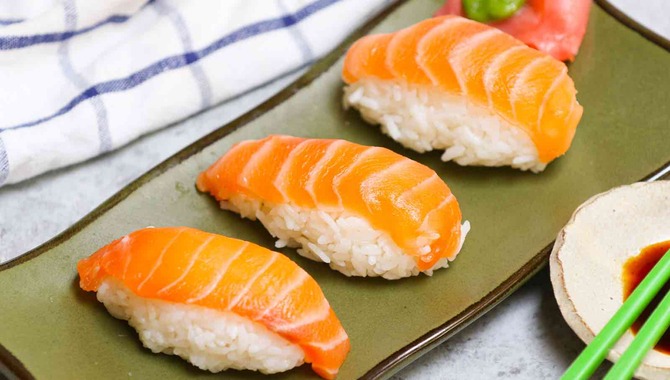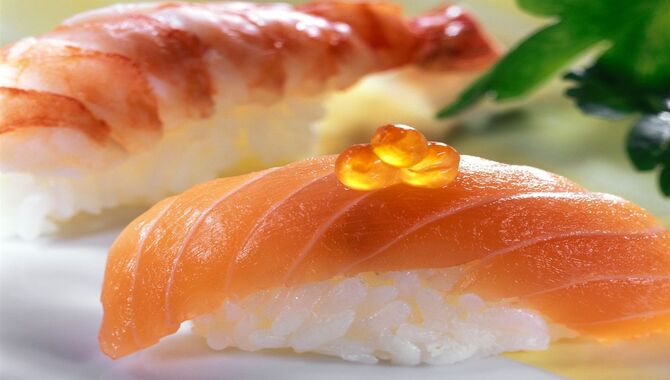Sushi is a classic Japanese dish combining vinegared rice with various ingredients like seafood, vegetables, and tropical fruits. It is commonly served with soy sauce, wasabi, and pickled ginger. There are different types of sushi, including nigiri, maki, and sashimi. You can enjoy sushi at restaurants or make it yourself using fresh ingredients and the right techniques.
Here we will cover how to prepare traditional sushi step by step. From gathering the freshest ingredients and essential tools to perfecting the sushi rice and handling and seasoning the fish. We’ll also explore various rolling techniques and sushi assembly methods, including nigiri sushi.
And, of course, we can’t forget about serving and enjoying your masterpiece. Whether you’re a beginner or an experienced home chef, our expert tips and techniques will elevate your sushi game. Get ready to impress your family and friends with delicious homemade sushi!

How To Prepare Traditional Sushi That Tastes Authentic

Preparing traditional sushi is an art form that demands precision and attention to detail. By adhering to centuries-old techniques, you can achieve a perfect balance of flavors and textures in every bite. Crafting sushi with care pays homage to Japan’s rich culinary traditions, ensuring an authentic and memorable dining experience.
Additionally, traditional sushi preparation allows endless creativity and innovation, empowering chefs to push the boundaries and create new and exciting sushi dishes. From selecting the finest ingredients to mastering the proper hand movements, pursuing perfect sushi is a journey that rewards both the diner and the chef. Here are guidelines on how to prepare traditional sushi.
1. Gathering Ingredients And Tools
To prepare traditional sushi, gathering the necessary ingredients and tools is vital. The success of your sushi depends on using high-quality ingredients like fresh fish, rice, and seaweed (nori). In addition to these, you’ll need specific tools such as a sharp knife, bamboo sushi mat, and wooden rice paddle.
It’s crucial to select the right type of rice, preferably short-grain, and cook it properly with the appropriate vinegar seasoning. Honing your technique in slicing the fish, shaping the rice, and assembling the sushi with nori or other wrapping materials is key. With these ingredients and tools, you’ll be well on your way to creating mouth-watering traditional sushi.
2. Preparing The Sushi Rice

To prepare traditional sushi rice, start with high-quality Japanese short-grain rice. Rinse the rice thoroughly to remove excess starch, then cook it according to the instructions or use a rice cooker. Transfer the hot rice to a large bowl and season it with vinegar, sugar, and salt.
Fold the seasoning in gently using a wooden paddle. Let the rice cool to room temperature before making sushi rolls or nigiri. Properly preparing the sushi rice creates the foundation for a perfect sushi dish, with a sticky yet firm texture that enhances the overall taste. Master the art of sushi rice preparation for authentic and delicious homemade sushi.
3. Handling And Seasoning The Fish

Properly handling and seasoning the fish are crucial aspects of preparing traditional sushi. When it comes to handling fish, it is important to prioritize food safety and the dish’s quality. Opt for fresh, high-quality fish that is specifically suitable for sushi. Utilize clean hands and utensils to avoid any cross-contamination.
The seasoning of the fish plays a vital role in enhancing the overall taste of the sushi. Balancing the flavors is key. Traditional condiments like soy sauce, wasabi, and other flavorings should be added in moderation to complement and elevate the fish’s natural flavors.
Rolling Techniques And Sushi Assembly
Mastering the art of rolling techniques and sushi assembly is crucial when it comes to preparing traditional sushi. These skills greatly influence this beloved cuisine’s taste, texture, and presentation.
Attention to detail is key, from ensuring the ingredients are rolled with precision to creating visually appealing presentations. You can indulge in an unforgettable sushi feast by evenly distributing the filling and embracing various rolling styles, such as make or temaki. Discover the joy of crafting perfect sushi rolls without starting with the primary key term.
Nigiri Sushi

Delving into traditional sushi, make way for the exquisite nigiri sushi. This esteemed culinary art form dazzles with its precision and attention to detail. Elevating simplicity to a new level, each nigiri sushi showcases delightful flavors.
Every bite is a sensory explosion, from the tender rice, perfectly cooked and seasoned with rice vinegar, to the thinly sliced fish or seafood that rests atop it. With each piece crafted lovingly with care and precision, nigiri sushi is also a feast for the eyes. Enjoy this Japanese short-grain rice marvel and experience a true culinary delight.
Serving And Enjoying
Serving and enjoying traditional sushi is an art that demands meticulous attention to detail and reverence for Japan’s ingredients and culinary legacy. When serving sushi in adherence to its time-honored customs, the pure essence of the fish and rice is allowed to take center stage.
A delightful harmony of flavors can be achieved by keeping condiments and garnishes to a minimum. Whether you choose to use chopsticks or your hands, it is crucial to relish each morsel gradually, savoring the intricate textures and nuanced taste profiles. By immersing yourself in this cultural tapestry, you unlock an authentic and captivating encounter with traditional sushi.
Tips For Enjoying Sushi

Choosing fresh, high-quality ingredients that elevate the flavors is crucial to fully enjoy sushi. Safety is paramount when preparing raw fish, so handle it carefully and adhere to proper techniques. Discover an array of sushi rolls and fillings to find the combinations that satisfy your palate.
Embrace the chopsticks and soy sauce, using them skillfully to enhance your dining experience. Pair your sushi with traditional Japanese drinks such as sake or fragrant green tea for a more authentic meal.
Conclusion
preparing traditional sushi requires attention to detail and a deep understanding of the techniques. From gathering the freshest ingredients to mastering the art of rolling and assembling sushi, each step is crucial in creating a perfect sushi experience.
Whether you’re a beginner or an experienced sushi lover, following these expert tips and techniques will ensure your sushi turns out delicious and authentic. So grab your ingredients, roll your sleeves, and prepare traditional sushi like a pro. Hope the above outline on how to prepare traditional sushi will be very helpful for you.
Frequently Asked Questions
What Goes Into Traditional Sushi?
Traditional sushi has vinegared rice, raw or cooked seafood, and seaweed. It comes in different forms like nigiri, maki, and sashimi. Additional ingredients can include vegetables, pickles, or sweet rolled omelets. The crucial elements are fresh ingredients and expert preparation.
What Are The Steps To Make Sushi?
To make sushi, cook the rice and spread it on a seaweed sheet. Add fillings in the center, then roll tightly using a bamboo mat. Finally, slice into bite-sized pieces with a sharp knife. Remember to moisten the knife for clean cuts.
What Are The 3 Main Ingredients In Sushi?
The three main ingredients in sushi are rice, fish or seafood, and seaweed. Sushi rice is a special type of seasoned short-grain rice. The fish or seafood options vary from salmon to shrimp, while seaweed (nori) adds flavor and wraps the sushi roll.
What To Serve With Your Sushi?
Traditional sushi is commonly served with soy sauce, pickled ginger, and wasabi. It can also be enjoyed with miso soup, edamame, or a side salad. Some may prefer tempura or gyoza as accompaniments. The choice of sides depends on personal taste and regional customs.
Why Is Sushi Rice Seasoned?
Seasoned sushi rice has a tangy and slightly sweet taste thanks to a combination of rice vinegar, sugar, and salt. It also helps bind the grains together for easier sushi roll formation. The balanced flavors of seasoned rice complement other ingredients, resulting in a delightful sushi dish.

I’m a writer and blogger who loves to talk about entertainment, culture, and relationships. I love to share my thoughts and insights on these topics, and I’m always looking for new ways to engage with my readers. I’m also a big fan of learning new things, so I’m always exploring new areas of interest.
